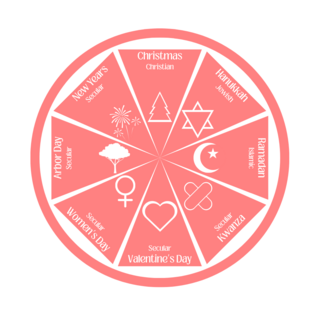
A holiday is a day or other period of time set aside for festivals or recreation. Public holidays are set by public authorities and vary by state or region. Religious holidays are set by religious organisations for their members and are often also observed as public holidays in religious majority countries. Some religious holidays, such as Christmas, have become secularised by part or all of those who observe them. In addition to secularisation, many holidays have become commercialised due to the growth of industry.

A festival is an event celebrated by a community and centering on some characteristic aspect or aspects of that community and its religion or cultures. It is often marked as a local or national holiday, mela, or eid. A festival constitutes typical cases of glocalization, as well as the high culture-low culture interrelationship. Next to religion and folklore, a significant origin is agricultural. Food is such a vital resource that many festivals are associated with harvest time. Religious commemoration and thanksgiving for good harvests are blended in events that take place in autumn, such as Halloween in the northern hemisphere and Easter in the southern.

Eid al-Fitr is the earlier of the two official holidays celebrated within Islam. Eid al-Fitr is celebrated by Muslims worldwide because it marks the end of the month-long dawn-to-sunset fasting of Ramadan. Eid al-Fitr falls on the first day of Shawwal in the Islamic calendar; this does not always fall on the same Gregorian day, as the start of any lunar Hijri month varies based on when the new moon is sighted by local religious authorities. The holiday is known under various other names in different languages and countries around the world. The day is also called "Lesser Eid", or simply Eid.
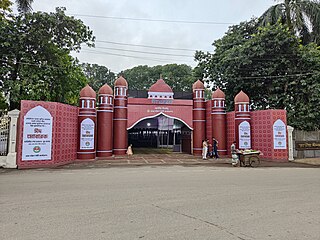
Eid al-Adha or the Feast of Sacrifice is the second of the two main holidays celebrated in Islam. In Islamic tradition, it honours the willingness of Abraham to sacrifice his son as an act of obedience to God's command. Depending on the narrative, either Ishmael or Isaac is referred to with the honorific title "Sacrifice of God". However, before Abraham could sacrifice his son in the name of God, and because of his willingness to do so, God provided him with a lamb to sacrifice in his son's place. In commemoration of this intervention, animals such as lambs are sacrificed. The meat of the sacrificed animal is divided into three portions: one part of the meat is consumed by the family that offers the animal, one portion is for friends and relatives, while the rest of the meat is distributed to the poor and the needy. Sweets and gifts are given, and extended family members typically visit and are welcomed. The day is also sometimes called the "Greater Eid".
Public holidays in Croatia are regulated by the Holidays, Memorial Days and Non-Working Days Act.
Yılgayah or Ulugh-Kun was the spring festival of Tengrism. It was celebrated on or about March 22, and marked the first day of the Turkic month of Oshlaq-ay. The holiday was celebrated with feasting and probably with sacrificial rites. The name of the holiday appears in the medieval dictionary Divan-i Lughat-it-Turk by Mahmud Kashgari, written in the 1070s.

Victory Day, also known as Turkish Armed Forces Day, is a public holiday in Turkey commemorating the decisive victory in the Battle of Dumlupınar, on 30 August 1922. It is also observed by Northern Cyprus.
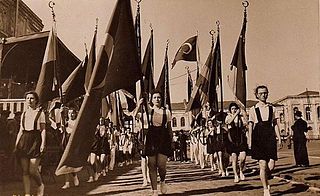
The Commemoration of Atatürk, Youth and Sports Day, is an annual Turkish national holiday celebrated on May 19 to commemorate Mustafa Kemal's landing at Samsun on May 19, 1919, which is regarded as the beginning of the Turkish War of Independence in the official historiography.
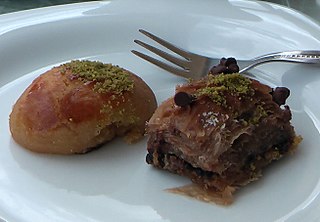
Kalburabastı or kalburabasma, and sometimes also known under the name of hurma, are syrup-drenched pastries that have a riddled appearance. They are featured among the favorite specialities that are prepared during the Islamic holidays, including the three-day Eid al-Fitr and Eid al-Adha.
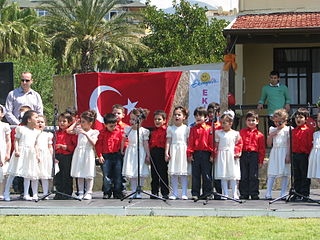
National Sovereignty and Children's Day is a public holiday in Turkey commemorating the foundation of the Grand National Assembly of Turkey, on 23 April 1920. It is also observed by Northern Cyprus.

Hıdırellez or Hıdrellez is a folk holiday celebrated as the day on which the prophets Al-Khidr (Hızır) and Elijah (İlyas) met on Earth. Hıdırellez starts on the night of May 5 and ends on May 6 in the Gregorian calendar, and April 23 in the Julian calendar. It is observed in Turkey, Crimea, Gagauzia, Syria, Iraq, the Caucasus, and the Balkans and celebrates the arrival of spring.

Republic Day is a public holiday in Turkey commemorating the proclamation of the Republic of Turkey, on 29 October 1923. The annual celebrations start at 1:00 pm on 28 October and continue for 35 hours.
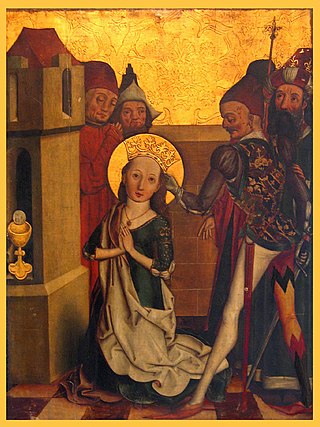
Eid il-Burbara or Saint Barbara's Day, and also called the Feast of Saint Barbara, is a holiday annually celebrated on 17 December or 4 December amongst Middle Eastern Christians in Lebanon, Syria, Jordan, Palestine, and Turkey. It is also celebrated as Barbaroba (ბარბარობა) amongst Christians in Georgia. Beyond its observance within Christian communities, Eid il-Burbara is also celebrated among the Alawite communities in certain regions. Its celebration shares many elements with Hallowe'en, though coming from a much earlier tradition, and unrelated to the feast of the dead. Traditionally, adults and children wearing disguise go around houses in the villages dancing and singing the story of Saint Barbara; and in each house, they are offered food specially prepared for that feast. The general belief amongst Levantine Christians is that Saint Barbara disguised herself as many different characters to elude the Romans who were persecuting her.
Payna or Paynaqan is a winter feast and festival Turkic Tengrism and Altai folklore. Arranged for the goddess that called Payna. So this is a blessing, fertility and abundance ceremony.
Kosa or Qochaqan is a spring feast and festival Turkic Tengrism and Altai folklore. Arranged for the god that called Kocha Khan. So this is a blessing, fertility and abundance ceremony.

Nardoqan or Nardugan was a Turkic holiday concept in Tengriism. Nowadays, it is most commonly used to refer to the winter solstice in many Central Asian and Siberian languages. The holiday is akin, both in terms of timing and also the concept, to Yalda Night. Given the historicity of Turko-Persian ties, and the symbolism of pomegranate fruit among Iranians during Yalda, the two festivities manifestly share origins. It is also used as an equivalent name for the Christian holiday Christmas.
Pakta or Paqtaqan is an autumn feast and festival Turkic Tengrism and Altai folklore. Arranged for the god that called Pakta. So this is a blessing, fertility and abundance ceremony.
Saya or Sayaqan is a summer feast and festival Turkic Tengriism and Altai folklore. Arranged for the god that called Saya Khan. So this is a blessing, fertility and abundance ceremony.

Eid al-Ghadir is an Islamic commemorative holiday, and is considered to be among the significant holidays of Shi'ite Muslims. The Eid is held on 18 Dhul-Hijjah at the time when the Islamic prophet Muhammad was said to have appointed Ali ibn Abi Talib as his successor. According to Shia hadiths, this Eid has been named "Eid-e Bozorg-e Elāhi", "Eid Ahl al-Bayt Muhammad" and Ashraf al-A'yaad.














